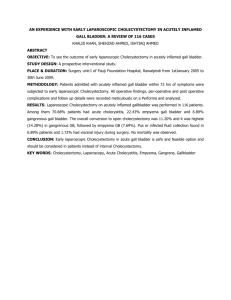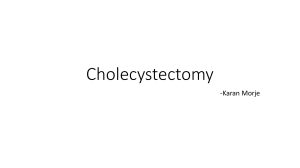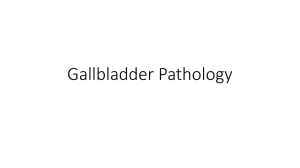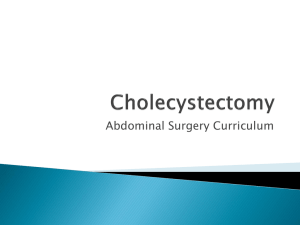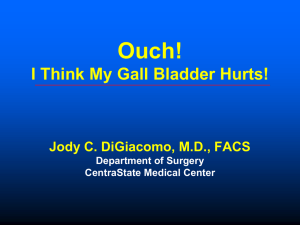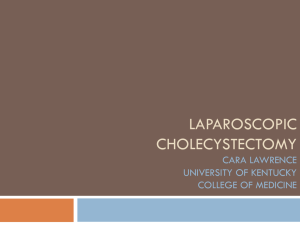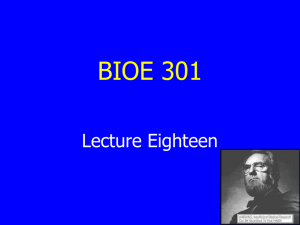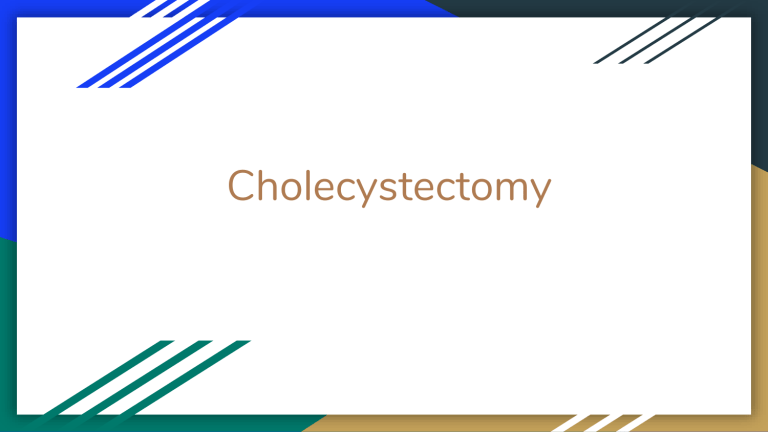
Cholecystectomy Cholecystectomy “Lap chole” A cholecystectomy is usually a laparoscopic procedure, but in cases where a laparoscopic cholecystectomy cannot be completed safely, an open cholecystectomy is indicated. (Open cholecystectomies are done in the event of abdominal trauma, bleeding complications, or unclear anatomy, although they are rare.) Cholecystectomy Cholecystectomy Indications/Contraindications Indications: ● ● Gallbladder issues ○ Biliary colic ○ acute/chronic/ acalculous cholecystitis ○ Choledocolithiasis Gallstone Pancreatitis Contraindications: Absolute: ● Inability to tolerate general anesthesia ● Suspicious for: bladder cancer Relative ● Pregnancy (1st or 3rd) ● Abdominal sx (precluding laparoscopic access) ● Cirrhosis, portal HTN, bleeding disorders Cholecystectomy Potential risks – ● ● ● ● ● Bleeding Infection Bile leak Intestinal injury Surgical/systemic complications ○ PNA, VTE, CV events ● Post-op Choledocolithiasis Cholecystectomy Benefits– ● Less discomfort than an open surgery ● Shorter hospital stay with a quicker recovery time when compared to an open surgery ● Smaller scars than regular surgery Cholecystectomy Technique – 1. 2. 3. 4. 5. 6. 7. 8. 4 small incisions are made in the abdomen: 1 periumbilical, 1 subxiphoid, 1 medial subcostal, and 1 lateral subcostal. The laparoscope is introduced through the umbilical trocar. A ratcheted toothed grasper is used to push the fundus of the gallbladder superiorly and laterally to reveal the infundibulum and porta hepatis. Another grasper is attached to the infundibulum to retract the gallbladder inferiorly and laterally to help visualize the cystic artery and duct. The cystic artery and duct are clipped and then transected. Electrocautery or a scalpel is then used to separate the gallbladder from the liver bed completely. The gallbladder is removed through the umbilical incision. Closure of port sites is surgeon specific, but fascial closure of sites greater than 5 mm is recommended. Cholecystectomy Complications ● Intestinal or mesenteric injury ○ Via: ● Bile leak ● Bile duct injury ● Gallbladder perforation ○ Spilled stone retention (10%) ● Common bile duct stone retention ● Vascular injury ● Postcholecystectomy syndrome Patient Education: Post-operative ● Analgesics: take as prescribed ○ Potential for pain: abdominal, shoulder, or neck ● Diet: clear liquids → as tolerated ● Length of stay: ○ Laparoscopic: same day ○ Open: 1-2d. hospital stay ● Activity: ambulation ○ Avoid heavy lifting, sports, & swimming x1 week Cholecystectomy Stool softener → narcotics ● Notify staff if any of the following present: ○ Fever, chills ○ Erythema/edema at ● ○ ○ ○ ○ ○ surgical site N/V Cramping, severe abdominal pain Jaundice: skin or eyes Dark urine Bloating
